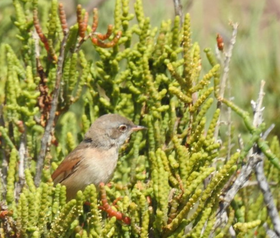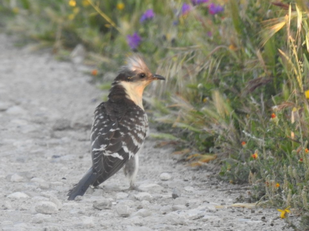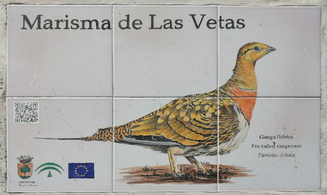 Spectacled Warbler hiding in halophytic vegetation
Spectacled Warbler hiding in halophytic vegetation  A Great-spotted Cuckoo Trebujena Marismas
A Great-spotted Cuckoo Trebujena Marismas  Yopu know you're in the right place when you see a sign like this!
Yopu know you're in the right place when you see a sign like this! .
| Birding Cadiz Province |
|
|
For an embarrassingly long time, Pin-tailed Sandgrouse was something of a 'bogey bird' for me in Cadiz Province although my chagrin at failing to find them was somewhat alleviated by the fact that other birders far more skilled than me also found them tricky to find. I confess that my efforts were somewhat hampered by the fact that, to maximise your chances of seeing them, it’s advisable to get on site either in the first or last few hours of the day. Since the species is only reliably found about an hour’s drive from my base this means getting up early or driving home in the dark, neither of which appealed to me (or even more so to Liz when she was out in Alcala with me). In fact, for years my only record in the province was of a small flock seen from the train as it passed the Marismas de Casablanca just north of Jerez. Hardly a satisfactory view but their portly plover profile was just enough to list them. Oddly, my first ever sighting of Black-bellied Sandgrouse was also from a train many years before. This was instrumental in my exploration of the Osuna area many years later. On that occasion the bird lifted off from near the track and obligingly flew along next to my window at close range before veering off into the distance. If only catching up with its congener in the marshes between La Algaida (Sanlucar de Barrameda) and Trebujena was that easy!  Spectacled Warbler hiding in halophytic vegetation Spectacled Warbler hiding in halophytic vegetation My search for Pin-tailed Sandgrouse in the province began in an area of halophytic vegetation beside the Guadalquivir north of the Salinas de Bonanza. I’d read somewhere that this area held sandgrouse and the habitat certainly appeared to be suitable. It also helped that the same source suggested the Spanish Imperial Eagle (which I hadn’t then seen for years) sometimes occurred here. I looked a number of times without finding my target species although I did see the eagle. In retrospect, or rather looking at e-Bird reports, I now realise that despite looking good this area is not a prime spot for the species (although good for both short-toed larks, Spectacled Warbler, Gull-billed Terns, etc.) In 2006 Lynx published the “Where to watch Birds in Doñana” written by two local experts which fortunately included this area (although not part of the Doñana National Park it’s part of the Natural Park that acts as a buffer zone). This excellent book suggested exploring a couple of tracks running north from the A 471 (at GPS 36.7774 -6.2774 (i) and GPS 36.7948, -6.26028 (ii)). These take you several km into the Marismas de Trebujena which is useful as there are few places you can legally or safely stop along the fast A 471 . In particular, they advised looking for sandgrouse in an area that both tracks converged upon (GPS 36.8226, -6.2671). I explored this area a number of times (albeit not always at the optimum time of day) and it certainly looks very good but have never got lucky. [Note that the last time I tried to reach this point from (i) the latter part of the track was in a very poor state so it’s quicker, easier and probably safer to come in from (ii)]. However, I have suggested to several people that they might give the area a try and they managed to find the sandgrouse here (sometimes after multiple attempts). Despite my lack of success these two tracks are always worth exploring as the area attracts, depending on season and rainfall, large numbers of egrets, Glossy Ibis and waders (inc. stints, Ruff, stilts, Golden Plovers), a variety of raptors (inc. Montagu’s Harrier, Short-toed Eagle, etc), short-toed and Calandra Larks.  A Great-spotted Cuckoo Trebujena Marismas A Great-spotted Cuckoo Trebujena Marismas birdingcadizprovince.weebly.com/cadiz-birding-blog/may-2022-update-vi-trebujena-area-going-gaga-or-going-gaaa-gaaaA third track along the A 471 next to “Trebujena Motorland” (iii - GPS 36.8365, -6.2065) is also worth a closer inspection as it runs for c5 km and offers good views across suitable habitat. When there’s standing water here then you can see hundreds of egrets and Glossy Ibis – wonderful sight. I’ve visited the area several times and many good birds here … except, of course sandgrouse. Unfortunately, a change in my personal circumstances and then Covid meant for over six years I was unable to give this area the time it deserved. So, when I returned in spring 2022 tracking down the elusive bird was a priority. I confess I was somewhat miffed when a keen Dutch birder to whom I gave details of one of the sites off the A 471 popped along and, on his first attempt, saw several sandgrouse (both in flight and on the ground). Naturally, when I looked there at dawn the following morning, I saw none at all, but my efforts were rewarded by finding a handsome Great-spotted Cuckoo. My catalogue of failure, however, lasted less than an hour when I checked the Adventus track (iv – GPS 36.8862, -6.2202). (Note the finca here is variously called the Cortjo Alventus or Cortijo de Adventus). Stopping along the track to scan the marismas, I saw a small group in the distance and then had a couple of Pin-tailed Sandgrouse fly over my head (see https://birdingcadizprovince.weebly.com/cadiz-birding-blog/may-2022-update-vi-trebujena-area-going-gaga-or-going-gaaa-gaaa). Somewhat to my surprise, I managed to repeat this feat at the same site the following autumn when I managed to show them to an old friend. A keen world birder (with a 7,000+ list), he’d leapfrogged Spain in pursuit of birds in more exotic destinations further afield, so the birds were lifers (as were another handful of species on that visit). This spring keen to check whether my sudden success was a fluke, I visited the Adventus track half-a-dozen times. To my great satisfaction, I saw Pin-tailed Sandgrouse every time including several small groups (4-5 birds) and probably had a group of c20 birds too. The latter were rapidly scuttling across the horizon as I got out of the car so it’s hard to to be 100% certain. Not only that but on three of those occasions birds flew over the track itself. What made the experience still sweeter was that on those three visits where the birds flew over nearby I was able to show them to four friends for whom they were lifers and a fifth who had never seen them before in Andalucía. My winning strategy has been to get there as early as possible when the birds are more active and the heat haze less of a problem, drive 200-300m along the track, stop and methodically scan the extensive marismas to the west. (Note that after rain this track can become dangerously slippery and driving along it is then inadvisable). In this way I’ve repeatedly found groups of sandgrouse flying fast and low over the marismas with some pitching down towards the Guadalquivir, others disappearing into cover near the small reserve and others continuing well into the distance. The birds, of course, know my strategy which is why the birds that came close to the track were all trying to sneak past behind me! A word of warning is needed though. Somewhat surprisingly, on all my recent visits there have been large numbers of Grey Plovers (in various plumages) doing pretty much the same thing whilst, less surprisingly, I’ve seen Golden Plover nearby in the past. Plovers can superficially resemble sandgrouse in flight but with a decent view there shouldn’t be a problem. However, they do constitute ornithological ‘white noise’ that can distract and make it easier for the target birds to slip through unnoticed! Even when the sandgrouse aren’t being obliging there’s still plenty to see – Little Owl, Glossy Ibis, Calandra Larks, raptors, etc. It’s well worth exploring further along the track for sandgrouse as not only is there plenty of suitable habitat but also after c3 km handsome ceramic sign decorated with an illustration of the bird itself, useful confirmation that you’re in the right place! The ditches here conceal a good variety of herons (I’ve had all three egrets, Grey, Purple, Night and Squacco here) and when flooded with shallow water (a rare circumstance in recent years) it attracts large numbers of Glossy Ibis and waders. Here the track bends to the left to continue all the way to Trebujena (c5 km). This route would certainly be worth exploring further as sandgrouse-friendly habitat continues until it reaches the low hill on which Trebujena stands whereupon good Rufous Bushchat habitat takes over. However, the condition of the track quickly deteriorates from this point on so it’s probably better to do so on foot. If arriving from Trebujena the track (v) starts at GPS 36.8688, -6.1799 next to the far end of Parque La Toya. If you do explore this area then feedback would be very useful as I’ve only done so a couple of times and even then fairly briefly (it's easy to be distracted by the many good ‘known’ sites locally!).  Yopu know you're in the right place when you see a sign like this! Yopu know you're in the right place when you see a sign like this! It’s well worth exploring further along the track for sandgrouse as far as the Marismas de las Vetas. Not only is there plenty of suitable habitat for sandgrouse but also after c3 km handsome ceramic sign decorated with an illustration of the bird itself, useful confirmation that you’re in the right place! The ditches here conceal a good variety of herons (I’ve had all three egrets, Grey, Purple, Night and Squacco here) and when flooded with shallow water (a rare circumstance in recent years) it attracts large numbers of Glossy Ibis and waders. Here the track bends to the left to continue all the way to Trebujena (c5 km). This route would certainly be worth exploring further as sandgrouse-friendly habitat continues until it reaches the low hill on which Trebujena stands whereupon good Rufous Bushchat habitat takes over. However, the condition of the track quickly deteriorates from this point on so it’s probably better to do so on foot. If arriving from Trebujena the track (v) starts at GPS 36.8688, -6.1799 next to the far end of Parque La Toya. If you do explore this area then feedback would be very useful as I’ve only done so a couple of times and even then fairly briefly (it's easy to be distracted by the many good ‘known’ sites locally!). Returning to where the Adventus track leaves the road down to the Guadalquivir turn left and park near the ruined tourist development (Chozas Marismeñas). From here you have a good view across the dry halophytic vegetation. If the reserve here is open (it rarely seems to be) then a still better spot would be the small tower in its southern corner. Similarly scanning from the Carretera del Práctico could get results. Personally, I’ve never seen sandgrouse from either location but others have and some of the birds I have seen appeared drop down into that area. A final word. I remain somewhat puzzled why I managed to miss this species in this area for so long. I’m willing to accept that it might be sheer incompetence but, that said, I’ve regularly picked them up here before some of the excellent birders who’ve come with me to search for them and back in the day my hearing was up to detecting their calls at much greater range. The fact is that the birds seem to cover an enormous area as I've picked them up as dots on the western horizon, followed them as they rocketed past and then lost them again as they reverted to dots on the eastern horizon. Perhaps, the alarming desiccation of the Coto Doñana has pushed more birds across the river or maybe, more optimistically, that process has increased the species’ population which is now overflowing across the Guadalquivir.
.
0 Comments
Leave a Reply. |
About me ...Hi I'm John Cantelo. I've been birding seriously since the 1960s when I met up with some like minded folks (all of us are still birding!) at Taunton's School in Southampton. I have lived in Kent , where I taught History and Sociology, since the late 1970s. In that time I've served on the committees of both my local RSPB group and the county ornithological society (KOS). I have also worked as a part-time field teacher for the RSPB at Dungeness. Having retired I now spend as much time as possible in Alcala de los Gazules in SW Spain. When I'm not birding I edit books for the Crossbill Guides series. CategoriesArchives
May 2023
|